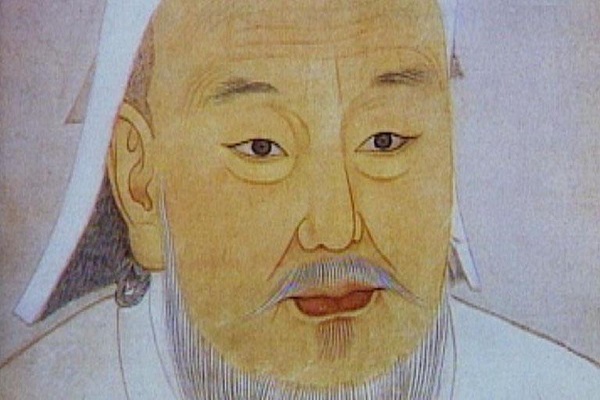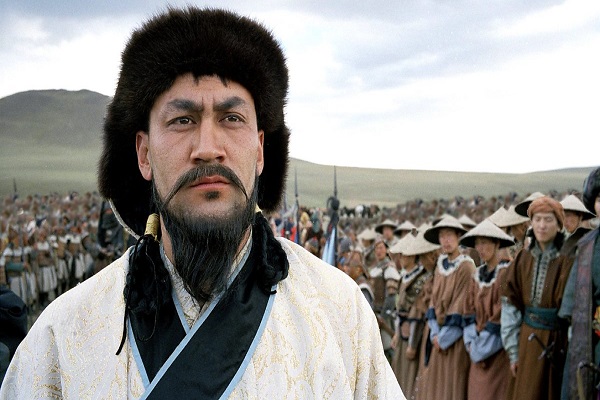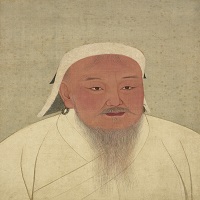Chinggis Khan, also known as Genghis Huangdi, was the founder and 1st Khagan and Mongol Empire’s Emperor. After his death, this empire became the biggest empire. He united several nomadic tribes in Northeastern Asia and became powerful. After establishing the Empire, he conquered Eurasia.
The campaigns he initiated were against Western Xia, Jin Dynasties, Khwarezmia, Qara Khitai & raids into Volga Bulgaria, Kievan Rus’, and Medieval Georgia. These campaigns led to the killing of many people, especially in Western-Xia and Khwarazmian-controlled lands.
Because of this killing and brutality, many people considered him a brutal ruler. Khan’s Empire conquered a grand portion of China & Central Asia. With his extraordinary military successes, he is known as the greatest and successful conqueror in history. This article contains all the information about him, including Chinggis Khan Biography.
| Title | Description |
|---|---|
| Personal | |
| Name: | Chinggis Khan |
| In Urdu: | چنگیز خان |
| Alternate name: | Genghis Khan |
| Famous As: | Chingaiz Khan |
| Real name: | Temüjin |
| Nationality: | Mongolian |
| Born | |
| Date: | 1162 |
| Place: | Delüün Boldog, near the mountain Burkhan Khaldun and the rivers Onon and Kherlen in modern-day northern Mongolia, close to the current capital Ulaanbaatar |
| Family | |
| Ethnicity: | Borjigin |
| Spouse: | Börte ,Üjin Khatun Yisui, Kunju Khatun, Khulan Khatun, Yesugen Khatun, Yesulun Khatun, Isukhan Khatun, Gunju Khatun, Abika Khatun ,Gurbasu Khatun, Chaga Khatun, Moge Khatun |
| Children: | Jochi, Chagatai, Ögedei, Tolui, others |
| Parents: | Yesügei, Mother:Hoelun |
| Died | |
| Date: | 18 August 1227 |
| Reign: | Spring 1206 – August 18, 1227 |
| Coronation: | Spring 1206 in a kurultai at the Onon River, Mongolia |
| Successor: | Ögedei Khan |
Table of Contents
Chinggis Khan Biography
Genghis was a genius ruler and warrior, beginning from insignificant and obscure beginnings. He took all nomadic clans of Mongolia under his control & his families in a firmly organized military system. Khan then switched his focus to settled populations outside the boundaries of his nomadic domain.
He started a series of plundering and invasion campaigns that ultimately led the Mongol armies to the Adriatic Sea in one path & the Pacific coast of China, resulting in the founding of the Grand Mongolian Empire. The history of the early life of Temüjin is doubtful. His birth year maybe 1155, or 1162 or 1167.
As per legends, his birth was wondrous because he opened his eyes into the world, holding a blood clot in his hand. Khan is often said to have been of spiritual descendants, his 1st ancestor being a grey wolf, ‘conceived with luck from paradise on high.’ Yet his teen period was difficult.
Chinggis Date of Birth
Very little information is known about the early life of Khan because of the lack of written records. His birth name ‘Temujin’ was taken from a Mongol word ‘Temur’ that means ‘of Iron,’ and Jin denotes the agency. So Temujin means ‘Blacksmith.’ Probably he opened his eyes in 1162 in Deluun Boldog, modern-day ‘Northern-Mongolia.’
Chinggis Khan Family
Lineage
He belonged to Hotla Khan, and Khabul Khan, Ambaghai, from his father’s side; his father commanded Khamag Mongol federation and was the successors of Bodonchar Munkhag. When Jurchen Great Jin transferred its support in 1161 from Mongols to Tatars, they ruined Khabul Khan. His father Yesugei headed the Mongol clan.
Siblings & Early Life
He had 3-brothers Temuge, Hachuin, and Hasar, and 1-sister Temulen & 2-half brothers Belgutei and Begter. His early life was complex and tough; his father delivered him to his future wife’s family at age nine. He had to live there acting as head of Dai Setsen until he reached the marriageable age, i.e., twelve years.

His father’s enemies gave him poisoned food, and Temujin came back home to take the position of his father as a chief, but the tribe didn’t allow him to be chief and abandoned this family who lived a difficult life without any resources and survived on wild fruits and small game animals killed by sons of the family.
Wives, Children, and Concubines
As per tradition, Genghis had several concubines and wives. He used to get concubines and wives from societies and empires that he occupied. He gifted many of his superior status spouses their own camps or ordos to live in. Each camp contained concubines, junior wives, and kids.
Guards of the Empire were assigned to protect ger of Genghis’ wives. The guards were given the responsibility to pay special attention to that camp where Khan slept, which may change daily as he kept visiting different spouses.
Unity of Mongol Leagues
China’s Central-Asian plateau North got divided in the early twelfth century into many renowned tribal leagues, including Keraites, Khamag Mongols, Tatars, Merkits, and Naimans. These were against each other, as indicated by raids, plundering, and attacks.
Attempts to come into Power.
Temüjin began his rise to dominance by presenting himself as an associate to his father Yesugei’s and (blood brother or sworn brother) Toghrul, the Khan of the Keraites, and is best recognized by a Chinese title ‘Wang Khan’ that Jurchen Jin dynasty conferred him in 1197.
This partnership was strengthened for the first time when the Merkits caught Börte. Temüjin switched to Toghrul for support and guidance. Toghrul gave twenty-thousands of his Keraite fighters and proposed that Temüjin include his longtime friend Jamukha, who himself had been the Khan of his tribe Jadaran.
The campaign saved Börte and destroyed the Merkits; it opened the way for a division between Jamukha and Temüjin. Before this, they were blood-brothers intending to stay eternally loyal.
Separation Between Temujin & Jamukha
As Temujin and Jamukha lost their partnership, both of them began to consolidate influence, thus becoming enemies. Jamukha favoured the conventional Mongolian hierarchy, while Temüjin adopted a meritocratic approach.
Following his early downfall of the Merkits and the declaration by the shaman Kokochu that the Everlasting Blue Sky had conquered the world apart for Temüjin, Genghis khan began to rise to power.

Back to power
About 1197, Jin began an assault on their traditional slave, the Tatars, with the aid of the Mongols and Keraites. Temüjin led most of this assault, and after the triumph, he & Toghrul were returned to positions of authority. Jin conferred on Toghrul the noble rank of Ong Khan and on Temüjin the lesser honor of j’aut Quri.
About 1200, the Mongol union’s major enemies were ‘Merkits’ to the north, and ‘Naimans’ to the west, ‘Jin’ to the east. and ‘Tanguts’ to the south. In his reign and his invasion of competing tribes, Temüjin split with the Mongolian custom in a few critical respects. He delegated power on the grounds of merit and honesty instead of family relations.
Rivalry with Toghrul
Senggum, Toghrul’s son, envied the increasing power and friendship of Genghis Khan to his father. He planned to kill Genghis Khan. While Toghrul was reportedly rescued on Genghis Khan numerous times, he decided to support his son and became unsupportive to Genghis Khan. Khan was informed of Senggum’s plans and finally beat him and his supporters.
Main Cause of Rivalry
One of the subsequent splits between Genghis and Toghrul was the refusal of Toghrul to send his daughter to Jochi, the first son of Genghis Khan, for marriage. In Mongolian society, this was insulting and led to violence. Toghrul collaborated with Jamukha, who had already opposed the armies of Genghis Khan.
However, the conflict between Jamukha and Toghrul, plus the abandonment of a majority of their associates to Genghis Khan, led to the defeat of Toghrul. This defeat acted as a trigger for the decline and subsequent collapse of the tribe of Keraite.
Ruled Mughal Plains
The portion of the Merkit tribe that aligned with Naimans was conquered by Subutai, who had become a part of Genghis’ personal guard, and subsequently was among Khan’s most powerful commanders. Naiman’s fall left Genghis the single emperor of the Mongolian steppe-all influential confederations unified under his Mongolian confederation.
A series of deceptions and betrayals characterize the accounts of the life of Genghis Khan. These involve conflicts with his former associates, including Jamukha and Wang Khan, his son Jochi.
Military Tactics of Khan
His military tactics displayed a keen interest in acquiring information and knowing his enemies’ intentions, demonstrated by his vast spy network & Yam Route Networks. He appeared to be a fast pupil, embracing the innovations and concepts he had heard, such as the Chinese siege war.
He was also merciless, shown by his methods of assessing against the linchpin, employed against the clans headed by Jamukha.

Chinggis Khan Achievements
Consequently, by 1206, Khan tried to unite or subdue under his control the Uyghurs, Tatars, Keraites, Mangols, Naimans, and Merkits. It was a monumental achievement and resulted in reconciliation between the former warring factions and a single military and political power.
This union became recognized as Mongols. At Khuruldai, the Council of Mongolian Chiefs, Genghis was recognized as the Khan of United Clans and got the new title of ‘Genghis Khan.’
Religion
Khan was a follower of Tengrism and was keenly interested in learning moral and philosophical lessons from different other religions. He consulted Muslims, Qiu Chuji, Buddhist, and Christian Missionaries. He invited and met with the Daoist Instructor Qiu Chuji 1222 in Afghanistan and expressed gratitude to Qiu Chuji for honoring his invitation and questioned if Qiu Chuji could give him eternity medicine.
Qiu replied that there is no such object as an immortality drug, but life could be prolonged by self-control. Genghis was appreciative of his truthful response. Qiu passed away in Beijing in the same year that Khan and his tomb became White Cloud Temple.
Military Campaigns
Jin Dynasty
In 1211, just after the invasion of Western Xia, Khan again decided to invade the Jin dynasty. Field commander Wanyan Jiujin of Jin Army made a strategic mistake not to attack the Mongols at 1st chance.
Rather the Jin Leader sent a message via, Ming’an, to the Mongolian part, who informed the Mongolians that Jin Force was awaiting across the other side of a Pass. The Mongols killed hundreds and thousands of Jin military personnel in Yehuling during this engagement.
Qara Khitai
Genghis planned to overcome Qara Khitai and destroy Kuchlug. During that time, the Mongolian military had been weakened from 10-years of relentless warfare in China against the Jin dynasties and Western Xia. Thus, under the guidance of his youngest general, Jebe, Genghis only sent 2-tumen (20,000 military personnel) against Kuchlug.
With such a tiny army, the invading Mongolians were expected to modify their plans and switch to stirring internal rebellion among supporters of Kuchlug, rendering Qara Khitai quite susceptible to Mongolian invasion. As a consequence, Kuchlug’s forces were defeated by Kashgar West.
Appearance
Unlike other emperors, Khan hadn’t ever permitted his picture to be shown in sculptures or paintings. The first known photographs of Genghis were created nearly 50 years after his demise, including a portrait of the best known ‘National Palace Museum.’
Although the portrait in that Museum is frequently seen as the nearest similarity to what Khan really looked like. In Persia, Khan was pictured as a Turkish emperor, while his portrait in Europe showed him an unattractive barbarian with a ruthless face and evil eyes.

Descriptions in Modern Civilization
Several films, adaptation works, and novels have been produced on the Mongolian emperor.
Short Stories
- The Private-Life of Genghis Khan
Music
- A heavy metal band ‘Iron Maiden‘ launched an instrumental track entitled ‘Genghis Khan’ in their album Killers.
- The Miike Snow band in 2017 released a song, Genghis Khan.
- The Hu, a Folk-Rock band of Mongolia, launched a song ‘The Great Chinggis Khan’ in Aug 2019.
Poetry
- The Squire’s Tale by Geoffrey Chaucer
- The poem End of Genghis by F.L. Lucas
Video Games
- Crusader Kings II
- Age of Empires 2: The Age of Kings
- Deadliest Warrior: Legends
- Sid Meier’s Civilization
- Genghis Khan: Aoki Ookami to Shiroki Mejika 4
TV Series
- A 1987 TV Series of Hong Kong produced by Television Broadcasts Ltd (TBV)-Genghis Khan
- A 1987 TV Series of Hong Kong produced by ATV (Asia Television Ltd)-Genghis Khan
- A 2004 Mongolian-Chinese co-produced TV series, casting Ba Sen-Genghis Khan
Novels
- Steppe by Anthony
- Novel Series the Conqueror by Conn
- Genghis Khan in Metro 2033
Films
- A Philippine film ‘Genghis Khan’ directed by Conde
- A 1965 movie Genghis Khan
- The Conqueror starring Susan Hayward in the role of Borte and John Wayne in the role of Temujin
- Film Mangol by Sergei released in 2007
- Genghis Khan; To Ends of Earth & Sea
- A Mongolian film No Right to Die-Chinggis Khan, released in 2008

Chinggis Khan Death
Khan passed away in Aug 1227, during the downfall of Yinchuan, Western Xia’s capital. The reason for his death is a mystery. His death cause is mentioned in ‘The Secret History of Mongols’ as falling from a horse during hunting and passed away due to this injury.
While Galician–Volhynian Chronicle blames Western Xia for killing Khan and Marco Polo stated the arrow infection as a cause of his death. Khan asked some years before his demise to bury him according to the tribe’s customs, i.e., without any marks.
When he passed away, his dead body was moved to Mongolia. His Mausoleum was built a long time after his death in his memory

